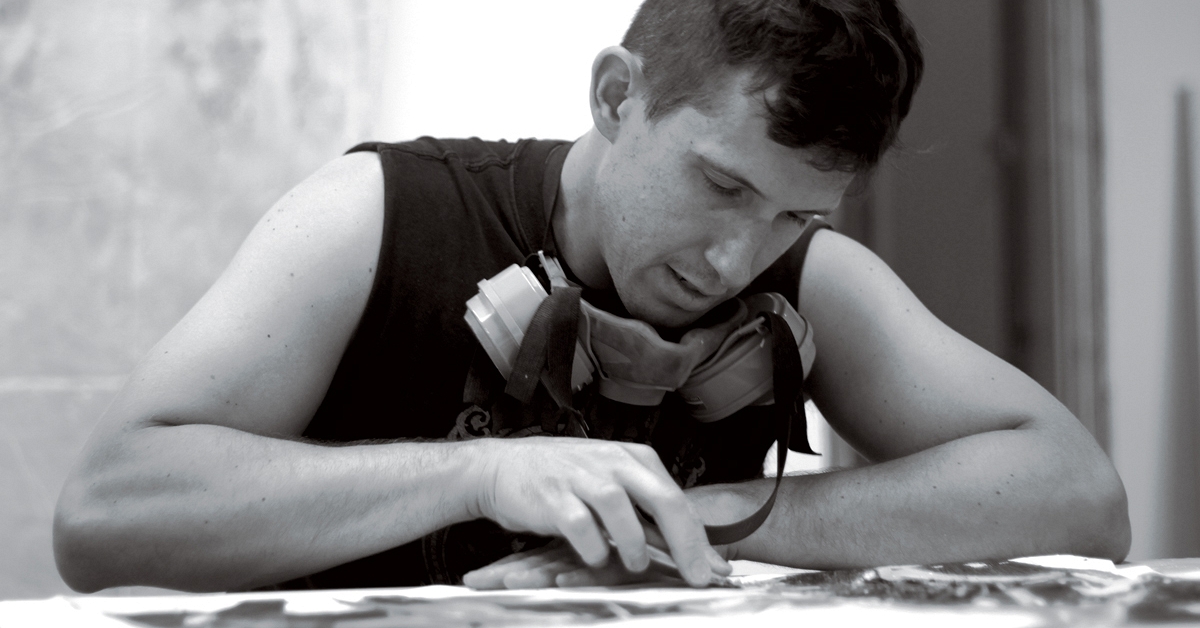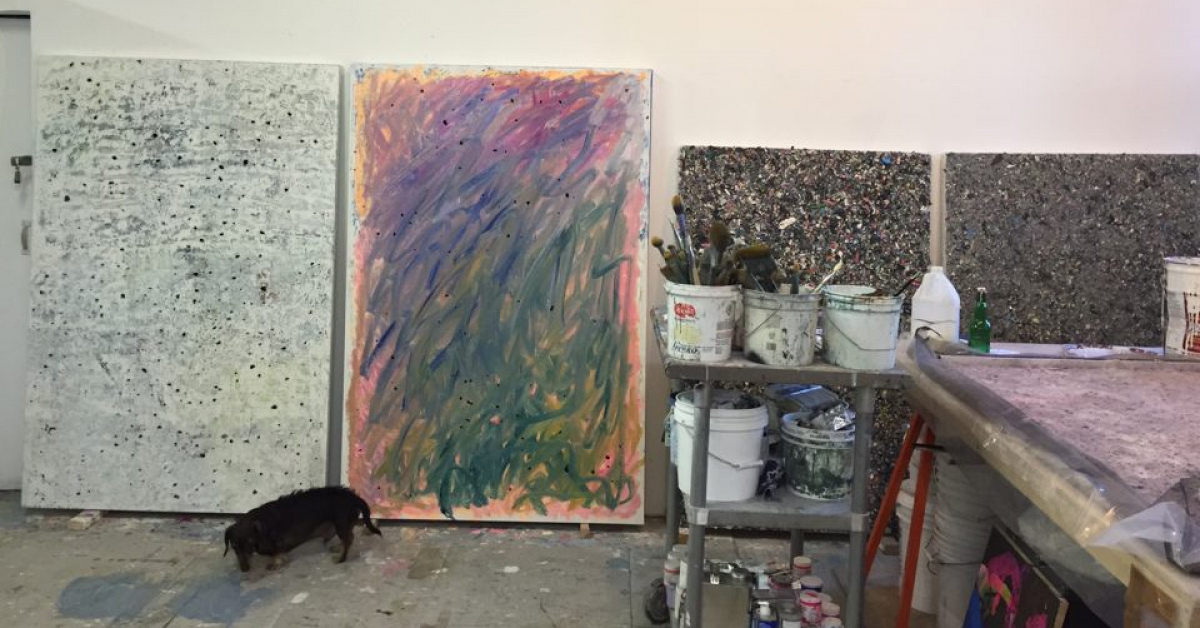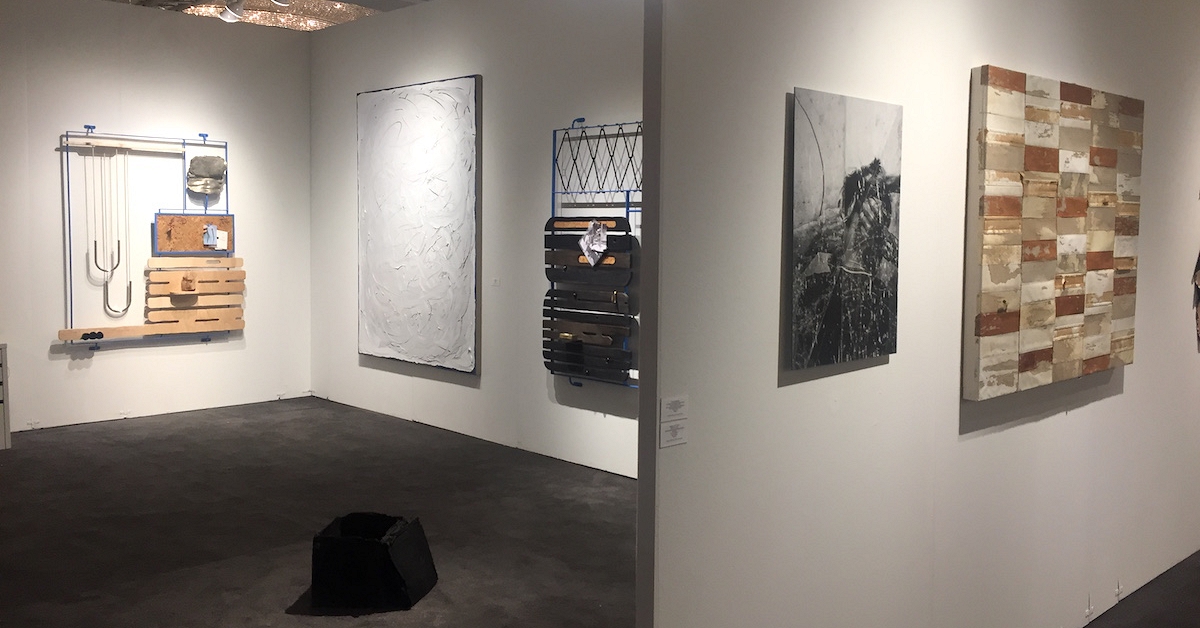Chicago Art Oximeter: A Review of LatinXAmerican at the DePaul Art Museum
New City Art / Jul 23, 2021 / by Ruslana Lichtzier / Go to Original
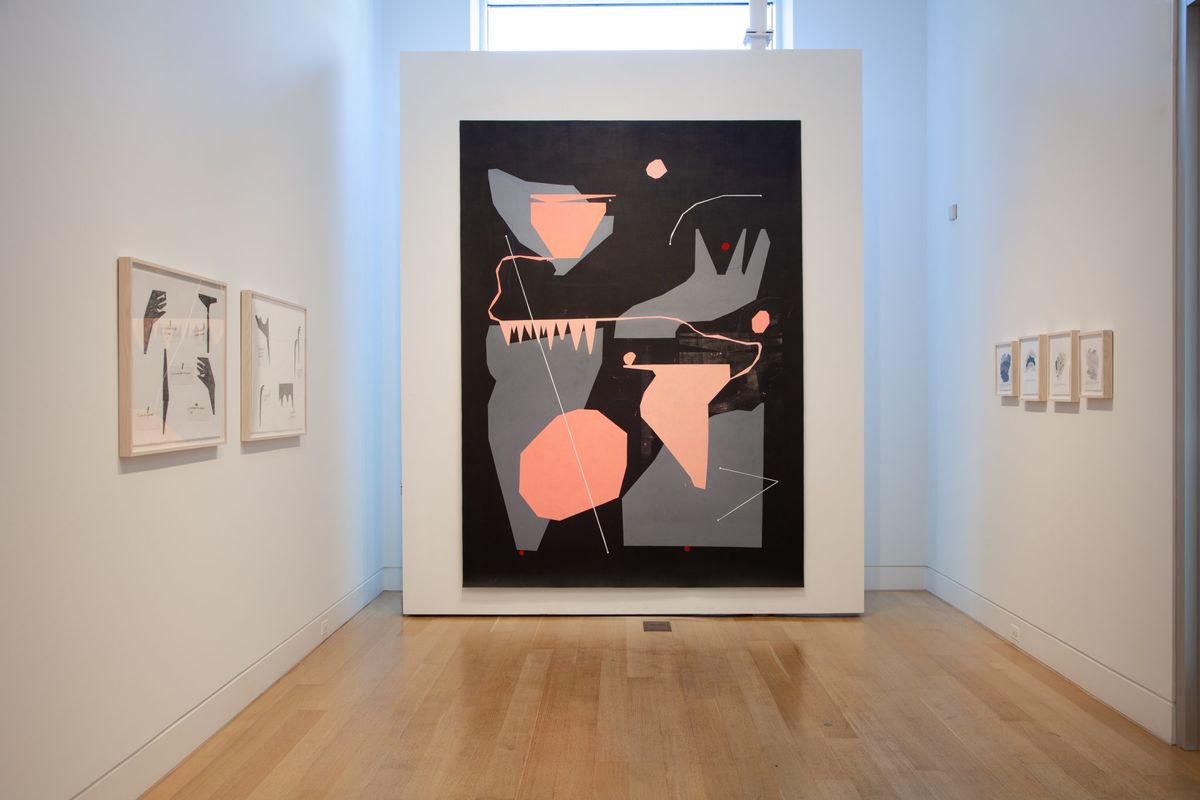
Installation view, “LatinXAmerican" DePaul Art Museum 2021/Courtesy of DePaul Art Museum
DePaul Art Museum, which since 2015 was guided by Julie Rodrigues Widholm, had become a significant and exciting institution. Under Widholm’s directorial and curatorial guidance, the museum furthered its already deep involvement in the global and, significantly, local art scene, as well as its engagement in decolonizing practices, presenting works by Latin American artists as well as by Latinx, and artists from the African Diaspora, Asian Diaspora, women, Indigenous people, LGBTQ artists and other underrepresented groups. The link between the local and the global proved to be a vital conduit for the production of exhibitions that are of special interest to the city.
Its current exhibition,“LatinXAmerican,” is an interesting case study for institutional survival under extreme circumstances; in recentyearsthe city’s art institutions have largely failed to stage engaging group exhibitions that highlight Chicago’s own talent. “LatinXAmerican,” which opened on January 7, features nearly forty U.S. and Puerto Rico-based artists of Latinx heritage, the majority of whom are from the city or who have spent some cold winters here. The exhibition was initiated by Widholm, but since Widholm left DePaul this year to take the role of the director at the UC Berkeley Art Museum and Pacific Film Archive (BAMPFA), it was largely left to be designed and produced by the museum’s staff, spearheaded by the assistant curator, Ionit Behar. Despite Widholm’s sudden departure, the exhibition echoes her commitment to revising historical and institutional commitments, and it is part of the museum’s multiyear research initiative which will focus on collecting, exhibiting and contextualizing Latinx artists, a minority group that was—and still is—marginalized within modern and contemporary art.
The title of the exhibition is telling. Its “X” does not stand only as a signifier of a nonbinary alternative to Latino or Latina. It also stands for the link and schism between the Latin and the American parts of identities in brown bodies; a schism that was recently heightened with the killings of two young brown men by the Chicago police in the span of two days during March. Adam Toledo, age thirteen, was shot by the police on March 29; Anthony Alvarez, age twenty-two, was shot by the police on March 31.
The exhibition, which is spread across the two floors of the museum, explores, as the wall-text outlines, “the shifting—and at times—contradictory—social, cultural, political, and artistic identities between Latinx artists of different circumstances and generations.” Notably, it is shaped by distinct curatorial gestures. First, national identifiers are omitted from the museum bilingual labels. (Museum labels in both Spanish and English are still, surprisingly, a rare find in the Midwest; it is time for the region to recognize its diasporic nature and embrace multilingual channels of communication.) The labels aim, as the wall-text clarifies, to “further problematize the traditional act of labeling that has historically been used in the museum field to identify artists.” Second is the exhibition’s design, which alternates between thematic arrangements and clusters of works that are linked with formal affinity. Lastly, “LatinXAmerican” has no exhibition guide, hence allowing the viewer to form their own reading of the different constellations. Not surprisingly, the most captivating moments in the exhibition are those that unite thematic framing with formal kinship. Such is the case in a first-floor gallery, which features works by Susy Bielak, Alejandro Jiménez-Flores, Harold Mendez and the collective Las Nietas de Nonó.
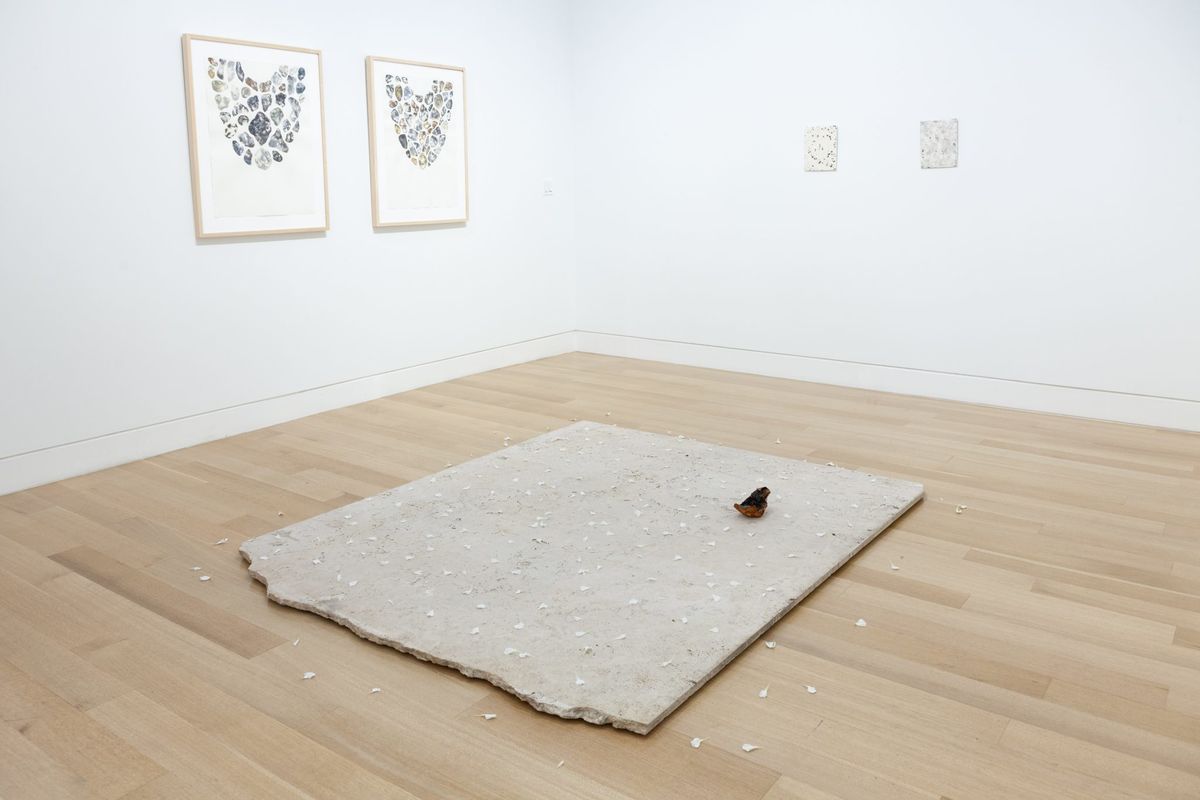
Harold Mendez, “Let us gather in a flourishing way," 2016, Travertine, oxidized copper reproduction of a pre-Columbian death mask from the Museo del Oro (Bogota, Colombia), water, carnations, Dimensions variable. Collection of DePaul Art Museum, Art Acquisition Endowment Fund 2017.8/Photo: Aron Grant. Courtesy of DePaul Art Museum
Harold Mendez, “Let us gather in a flourishing way,” 2016, Travertine, oxidized copper reproduction of a pre-Columbian death mask from the Museo del Oro (Bogota, Colombia), water, carnations, Dimensions variable. Collection of DePaul Art Museum, Art Acquisition Endowment Fund 2017.8/Photo: Aron Grant. Courtesy of DePaul Art Museum
Harold Mendez (b. 1977), a Chicago native who moved to L.A. a few years ago, has gained a considerable amount of national and international recognition in recent years. For Chicago art goers, he is a familiar and welcomed sight. Throughout the years, the city’s audience was offered the privilege of seeing Mendez’s growth in the local gallery, Patron, that represents him. The floor arrangement, titled “Let us gather in a flourishing way” (2016), consists of an approximately five-by-seven-feet light-tan travertine base, cut unevenly and with rough edges; on top is an oxidized copper reproduction of a pre-Columbian death mask from the Museo del Oro in Bogotá, Colombia. The mask, placed off-center, is turned upside-down, and used not as a facial veil but as a fragile vessel for water. Around it, carnation petals are spread. The work is an intimate and secretive ritual site of death, of memory and of resurrection.
Susy Bielak (b. 1976), another Chicago artist, presents “Breath Drawings” (2020): two framed works on paper at the scale of 22 ½ by 30 inches. “Breath Drawings” depict rocks, drawn with dark watercolors that stand out against the stark whiteness of the sheet of paper. Arranged in a reverse rainbow, or in the shape of a collar, they are inspired byhuipil, a traditional garment worn by Indigenous women from Mexico and Central America. The rocks’ pattern evokes the common floral patterns on the traditionally loose-fitting tunic, which originally were made from two pieces of fabric, that then were joined beneath the arms with ribbons or fabric strips. Bielak began this series in 2013, but she returned to it this year with new vivacity. During the isolated days of the pandemic, Bielak began walking daily at the shore of Lake Michigan, searching for basalt and granite rocks, and slag, which then entered into her drawings. The title, “Breath Drawings,” evokes the strange fear we have recently learned to hold so intimately. The fear of another person’s sign of life—their breath—but also, the fear of breath diminishing. Bielak, who is Jewish, explains that the works are “about breathing life into stone and memorializing the dead.” In the Jewish tradition, placing a stone atop a gravesite is a part of a bereavement ritual. In this reading, the drawings become drawings of visitation stones, which symbolize remembrance and respect for the dead. But breathing into a stone also recalls the first Golem, who, in the Jewish creation myth, was Adam; Adam was formed by God out of dust, who then breathed the breath of life into his nostrils. Bielak’s drawings become ritualistic acts that evoke both the end and the revolution of the circle of life.
Alejandro Jiménez-Flores (b. 1989), another Chicago local, presents five works of mixed-media on plaster. The approximately eight-by-ten-inch, wall-hung pieces contain pressed, gifted and collected flower petals, and marks of soft pastels. The titles—”buds—cruising” (2019), “tús labios—deseo” (2019), “learning to live finally…” (2018), “Forgiveness is an attribute of living matter” (2018) and “tú lip · s (2019)”—quote Clarice Lispector’s “The Passion According to G.H.,” as well as Derrida’s “Learning to Live Finally” and “Specters of Marx.” Derrida and Lispector provide suggestive keys to the works that open themselves up as objects of becoming which teach us how to live, and how to accept the unavoidable process of blooming, wilting and dying. This acceptance of the power of life and death is embedded in the works’ materiality, since Jiménez-Flores presses the petals before they are completely dried out, hence allowing them to continue and form their expressions by releasing their dyes onto the plaster. Similar to Bielak, Jiménez-Flores’ practice evokes rituals and witchcraft, or as they call it, “haciendo brujeria” (“doing witchcraft”). “Haciendo brujeria” is tied in Jiménez-Flores mind to their early childhood memories when they played with their cousin; together, collecting and submerging dried petals into a water-filled bucket, they stirred the potion with a stick, making “haciendo brujeria.”
Las Nietas de Nonó, a Puerto-Rican collective, present a single channel video, about twelve minutes long, “Interpretaciones de la Sal” (2016-2020). Las Nietas de Nonó is comprised of two sisters, Mulowayi Nonó (b. 1979) and Mapenzi Nonó (b. 1982). Self-defined as Afro-diasporic, the duo recently gained wide recognition with their participation in the tenth Berlin Biennial (2018) and the seventy-ninth Whitney Biennial (2019). “Interpretaciones de la Sal” captures the salt flats in Cabo Rojo, Puerto Rico. The video, which is accompanied with an Afrofuturistic soundtrack, presents a hovering viewpoint that floats in close proximity around the salt flats, exploring their desiccated whiteness, and at times revealing a Black arm that enters the frame while crushing the salt rocks. With its close proximity, the camera is effectively concealing large portions of the landscape that it depicts. The name, Cabo Rojo, which is translated to the “red cape,” stands for the famous red limestone cliffs that surround the white salt flats and the clear waters of Bahia Sucia. In their decision to omit the picturesque feature of this landscape, of the white salt flats, the red limestone cliffs and the clear blue water, the collective directs our attention to a different sight, the site of history that layers indigenous, colonial and neocolonial traces. The earliest evidence of salt mining in Cabo Rojo goes back to A.D. 700 and is attributed to the Arawak people. The Arawak became enslaved as salt miners by the Spanish invaders in the sixteenth century. Today, Cabo Rojo is still used for commercial salt extraction by the neocolonial U. S. agent, the Fish and Wildlife Service.
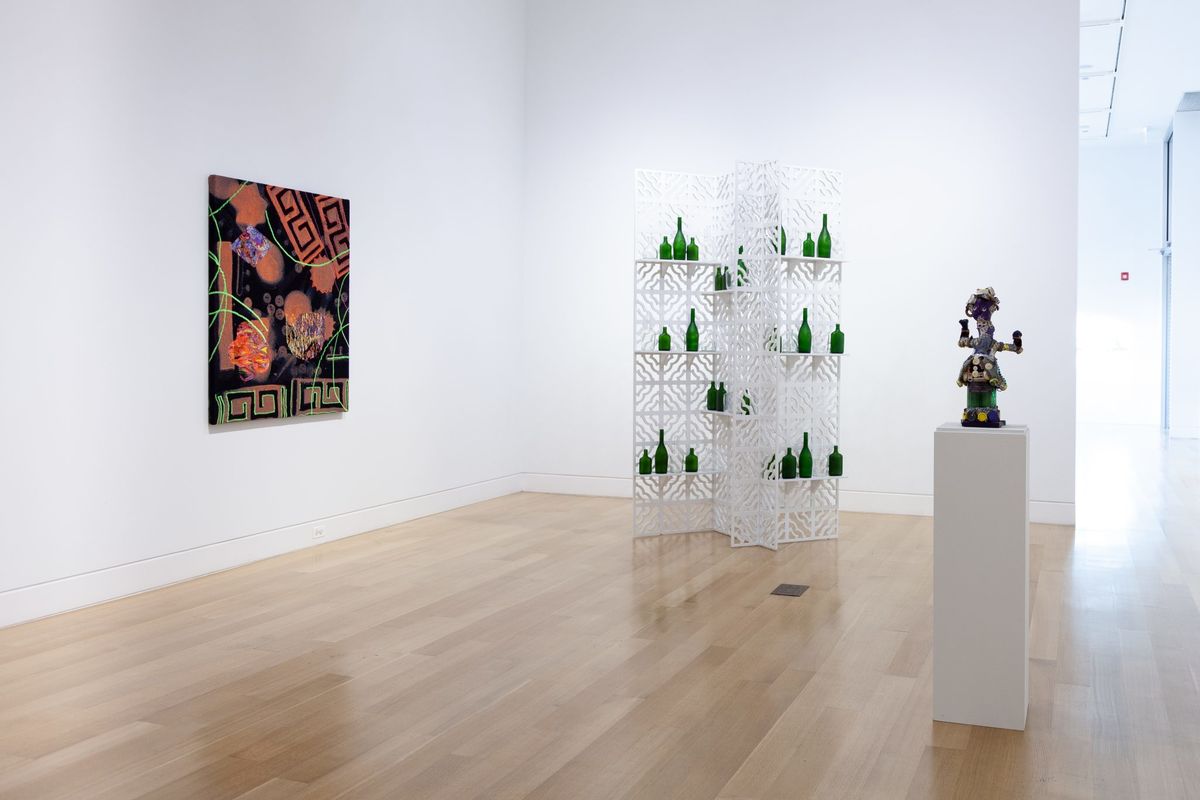
Installation view, “LatinXAmerican," DePaul Art Museum 2021/Courtesy of DePaul Art Museum
Similar demarcation of that which is out of sight also occurs in Mendez’s work. The oxidized copper reproduction of a pre-Columbian death mask from the Museo del Oro quietly directs our attention to a hidden history. The name of Museo del Oro evokes the myth of El Dorado, the lost city that Europeans were searching for for centuries. El Dorado, which is translated to “the golden one,” refers actually not to a city but to a ritual that was practiced by the Muisca, Quimbaya, Calima, Tairona, Tolima and Zenú people at Lake Guatavita, next to today’s Bogotá. Gold, which is the main material of the pre-Columbian death masks, signified the semi-divine status of the elites, rather than what it came to signify with the European invasion, mainly wealth and greed. The mask originally represented a microcosm of divine elements, a balance between opposites. Turned upside down, the mask represents the obliteration of these ancient cultures in the sixteenth century. But, as a vessel, it demands one—the museum’s staff—to attend to the traces of this obliteration daily, and to care for it; to fill the mask with water and to spread fresh petals. Through this daily practice, the work becomes again a space of ritual, albeit private and concealed, it presents a space of care.
This gallery, as a whole, produces a quiet contemplation site that brings together, beautifully, the rituals of mourning and of remembering, the appreciation of the revolution of death and life. It also reminds us that the crimes of past centuries did not end, and that only by remembering our pasts can we imagine different futures.
The exhibition, at large, contains of course many other artists and works of art. I chose to zero in on one constellation since the small room exemplifies the complexities of Latinx identities, who carry and express their histories with care and urgency. If one chooses to attend “LatinXAmerican,” while having in mind the guiding question, “What is Latinx art today, what does it look like,” I will assure you that the exhibition provides answers that are plenty. Since the answers are of a multitude, we may ask, what can identity-based exhibitions provide us with today? One answer is that identity—this monolithic X—is imposed on brown bodies with great violence by the state, and as long as those bodies are being discriminated against and killed, their identities must be attended to by cultural institutions, museums included. It is the museums that have the obligation to do restorative justice and to begin acquiring artworks that were historically ignored.
I would like to return to my original question, the question of the exhibition as a case study in institutional survival under extreme conditions. Due to Widholm’s departure, the exhibition’s design fell largely on current museum staff and interns. The assistant curator Ionit Behar has played a crucial role in this exhibition, finalizing the checklist with major changes and programming public events that accompany the exhibition. This decision, to turn to the assistant curator, was an unconventional one, and it proved itself to be successful. I am not surprised. Chicago has many talents that end up fleeing the city due to lack of opportunities. Thankfully, Behar is still here. Her deep understanding of the diasporic Latinx, as well as intimate knowledge of the local art scene, is what makes this exhibition vital.(Ruslana Lichtzier)
“LatinXAmerican” is on view at DePaul Art Museum, 935 West Fullerton, through August 15.

